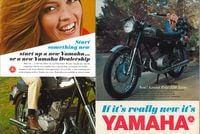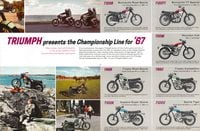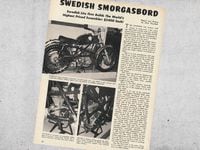The Covel — Brilliant Ingenuity in a Home-Built Racer
Ingenious motorcycle builders and their custom machines have always found their way onto the pages of Motorcyclist and "The Covel" feature about Hedley Cox and his home-built Velocette from our February 1967 issue is a great example. Cox had an impressive past that began as a wrench with the Velocette factory TT team in 1948. For two years he travelled to Grand Prix circuits all over Europe as a race mechanic until the bug to race grew too strong.
Cox raced for Velocette on a 350 KTT in 1950. Of special note in the 1967 article was the mention of his holding a third place in the Manx Grand Prix until “his carburetor fell apart”. At the end of the 1950 season Cox was let go from the factory team. This freed him up to follow on a new approach over the traditional British racing singles.
From this idea was born the Covel, which was a mash-up of the names Cox and Velocette. What Cox did was to marry two Velocette single in an effort to increase revs and power. Having an intimate knowledge of the Velocette platform, he used two 350cc Velocette engines that were reduced down to 250cc per engine and mated them to a pair of flywheels with a 58mm stroke and standard 74mm bore.
The left engine was converted to a right-side driveshaft which was then splined to the left motor for a center-driving sprocket. This layout required the gearbox to be mounted to the right hand engine and the drive chain to be moved to the left hand side of the bike. The chain was driven by a special outrigger plate from the clutch to an extension shaft with a ball bearing supporting the end of the shaft where a countershaft sprocket was in-line with the rear sprocket on the left side of the bike.
The article offers in great detail the steps taken to mate the two engines together. The end result was an enginethat was fitted into a Velocette KTT frame above the bottom frame tubes, which was a departure from the standard KTT 350 configuration that was usually set between the rails. Since each engine maintained it’s complete case, Cox was able to remove the left engine quickly to work on it or the right hand motor.
Amazingly, the Covel I was ready for a TT race by the Manx Grand Prix in 1951. Not knowing how much power he had, he geared the bike at 4.79 to 1. At the Isle of Man he found his engine would turn 8,000 revs in practice and on some of the downhill sections of the course this translated into 129 mph. On the mend from a crash, he did not race that day but walked away knowing his machine had passed the proof of concept and could run with the Norton Manx which was the fastest production racer at that time.
After recuperating from his crash he was able to race a few of the shorter courses on the Covel 1 including Caldwell Park, Silverstone, and Crystal Palace. All being shorter courses and being a hefty 390 pounds proved to be too cumbersome to reap any notable positions at these circuits. June of 1953 offered Hadley a chance to stretch out and take advantage of the power his homebrewed twin in a TT Race. Unfortunately, his big 1000cc Vincent twin decided to throw him at the 33rd milestone, which landed him in the hospital.
This was the effective end of the Covel I. Shortly after his crash he decided to emigrate to Canada and did so in 1955. His precious Covel I was left behind and did see a few races after his departure but nothing of note came of it. After some time in Canada, he moved to New York where he opened a bike shop before later enrolling in the University of Wisconsin and securing an engineering degree. Following that work, Cox moved to San Antonio, Texas, where he brought over what was known as the Covel II from England. This is a machine he had worked on shortly before leaving England and on a return trip in 1959. The main design changes between I and II was a new frame and radical steering/ front end job.
Now that the Covel II was in San Antonio with the newly minted engineer, he set to work on refining his new front end. What he set out to do was to bring the bearing point closer to the center of the wheel. By doing this he hope to alleviate a lot of the leverage on a traditional fork and maintain a constant wheelbase & fork trail no matter how far the wheel is depressed in the suspension process.
Although never achieving any impressive race victories, the Covel I and II always attracted a crowd of enthusiasts wherever they went, and they’ve added a colorful chapter to the history of motorcycling.
The Swedish Smorgasbord — Swedish Lito Firm Builds The World's Highest-Priced Scrambler: $2400 Each!
Swedish print firm Lito had become well known in European motocross circles a few years previous to this 1967 article when Sten Lundin rode their bike to victory the 500cc World Championship. The scrambler Lito brought to market (and the subject of this article) was wildly different than other machines available at this time.
The frame was characterized as “rigid and exceptionally strong” by applying aircraft principals. How they did this was by gluing lightweight aluminum tubes into Elektron sockets. This radically different frame housed a single-cylinder four-stroke engine.
The list of design elements that made this engine so radical included an X-cam rocker layout combined with pushrods that both moved up and down positively and could not “float” at high revs like most pushrod designs of the period. The valves were a hairpin style (see picture) and the clutch is mounted on the crankshaft to reduce weight. Another weight-saving design embellishment was the use of Swedish Stefa magnetos originally developed for chainsaws.
One item of concern is the oil tank. The tank is mounted under the motor and gearbox and is of some concern for the rough European circuits and the author suggested that it should be moved above the gearbox.
The Lito Scrambler is a bit of an international affair. The bike is built with BSA gearbox internals, Ceriani forks, an Amal Monobloc carburetor, and CZ wheels & brakes. The scramble is claimed to weigh 210 pounds but their own literature states that the bike weighs 100 kilogramme (spelling from article), which translates to 220 pounds.










/cloudfront-us-east-1.images.arcpublishing.com/octane/2H4AETL3IWCTW3QO47H5ZJXUT4.jpg)







/cloudfront-us-east-1.images.arcpublishing.com/octane/KIX5O23D5NAIBGFXBN3327DKZU.jpg)
/cloudfront-us-east-1.images.arcpublishing.com/octane/7GJYDUIPXRGMTMQKN6ONYOLBOU.jpg)
/cloudfront-us-east-1.images.arcpublishing.com/octane/MUQLOVLL2ZDGFH25ILABNBXKTI.jpg)
/cloudfront-us-east-1.images.arcpublishing.com/octane/TNOU5DNE2BC57MFPMGN2EIDXAM.jpg)
/cloudfront-us-east-1.images.arcpublishing.com/octane/GTCXACQGJ5HAPDTGWUQKDEH44E.jpg)
/cloudfront-us-east-1.images.arcpublishing.com/octane/S35YGSEMEZB4BLTDJTSZPF4GLA.jpg)
/cloudfront-us-east-1.images.arcpublishing.com/octane/5UOT6HPX2JFMRJAX6EH45AR4MQ.jpg)
/cloudfront-us-east-1.images.arcpublishing.com/octane/OKWOJWAKP5EP3OACCRRWPCIX2Q.jpg)
/cloudfront-us-east-1.images.arcpublishing.com/octane/2WF3SCE3NFBQXLDNJM7KMXA45E.jpg)
/cloudfront-us-east-1.images.arcpublishing.com/octane/G4MG6OUCJNBSHIS2MVVOTPX65E.jpg)
/cloudfront-us-east-1.images.arcpublishing.com/octane/IIGGWFOTOJGB7DB6DGBXCCMTDY.jpg)
/cloudfront-us-east-1.images.arcpublishing.com/octane/QSTCM6AVEZA5JJBUXNIQ3DSOF4.jpg)
/cloudfront-us-east-1.images.arcpublishing.com/octane/U4I7G625B5DMLF2DVIJDFZVV6M.jpg)
/cloudfront-us-east-1.images.arcpublishing.com/octane/B6XD6LS6IVCQPIU6HXDJSM3FHY.jpg)
/cloudfront-us-east-1.images.arcpublishing.com/octane/ICL63FEDDRDTTMINYICCEYGMDA.jpg)
/cloudfront-us-east-1.images.arcpublishing.com/octane/FCGZHQXRBZFLBAPC5SDIQLVF4I.jpg)
/cloudfront-us-east-1.images.arcpublishing.com/octane/WNOB6LDOIFFHJKPSVIWDYUGOPM.jpg)

/cloudfront-us-east-1.images.arcpublishing.com/octane/X33NU3E525ECRHXLNUJN2FTRKI.jpg)
/cloudfront-us-east-1.images.arcpublishing.com/octane/6KKT5NNL2JAVBOXMZYS5ZO76YA.jpg)
/cloudfront-us-east-1.images.arcpublishing.com/octane/J5RKG5O455GMPGQRF2OG6LRT7A.jpg)
/cloudfront-us-east-1.images.arcpublishing.com/octane/GX2CIZKQVRH2TATDM26KFG2DAE.jpg)
/cloudfront-us-east-1.images.arcpublishing.com/octane/ZWIDYSAKQZHD5BHREMQILXJCGM.jpg)
/cloudfront-us-east-1.images.arcpublishing.com/octane/CYUHJZCTSJCH3MRAQEIKXK7SCQ.jpg)